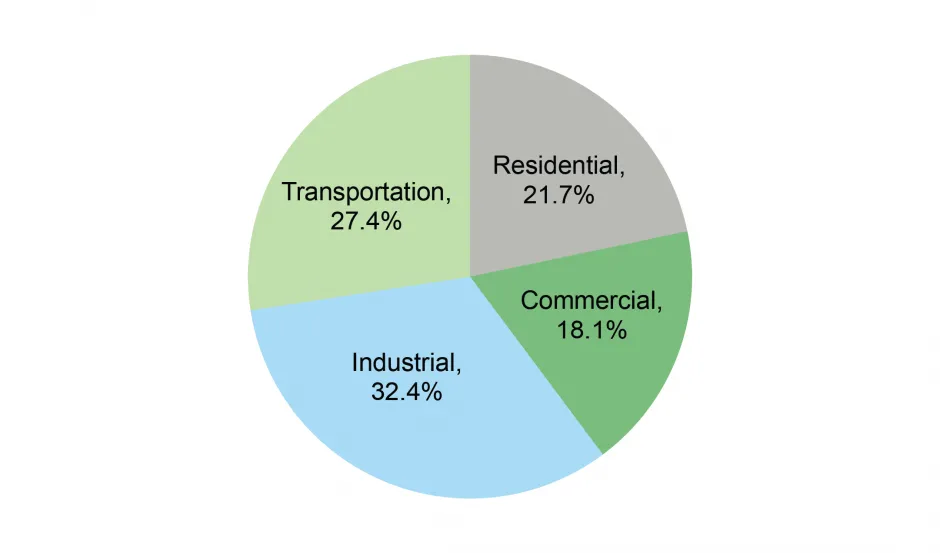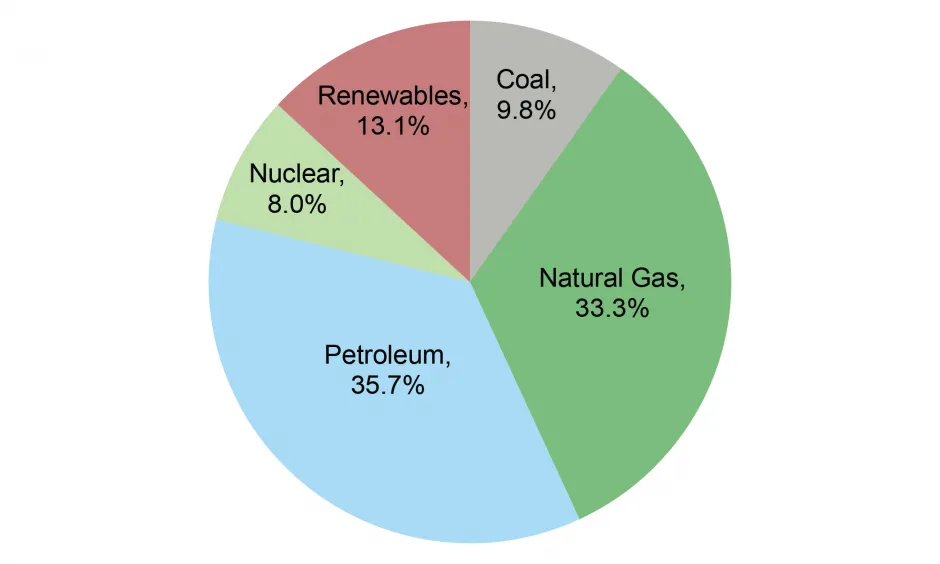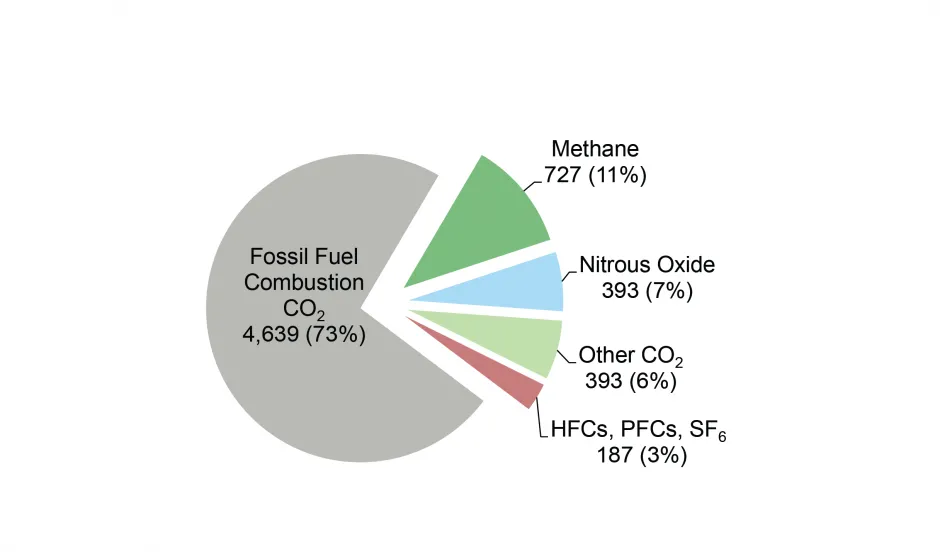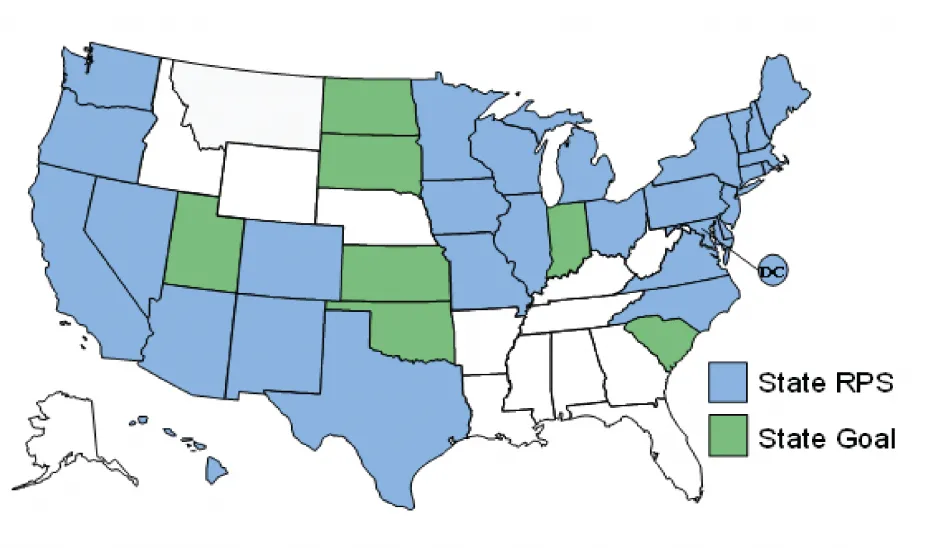U.S. Energy System Factsheet
Energy plays a vital role in modern society, enabling systems that meet human needs such as sustenance, shelter, employment, and transportation. In 2021, the U.S. spent $1.3 trillion on energy, or 5.7% of Gross Domestic Product (GDP).1 On a per capita basis, annual energy costs were $3,967 per person.1 Environmental impacts associated with the production and consumption of energy include global climate change, acid rain, hazardous air pollution, smog, radioactive waste, and habitat destruction.2 The nation’s heavy reliance on fossil fuels (primarily imported crude oil) poses major concerns for energy security. Potential gains in energy efficiency in all sectors may be offset by increases in consumption, a phenomenon called the rebound effect.3
U.S. Energy Consumption: Historic and Projected Values4,5

Patterns of Use
Demand
- With less than 5% of the world’s population, the U.S. consumes 16% of the world’s energy and accounts for 16% of world GDP. In comparison, the European Union has 6% of the world’s population, uses 10% of its energy, and accounts for 15% of its GDP, while China has 18% of the world’s population, consumes 27% of its energy, and accounts for 19% of its GDP.6,7
- Each day, U.S. per capita energy consumption includes 2.5 gallons of oil, 8.27 pounds of coal, and 261 cubic feet of natural gas.5,6
- Residential daily consumption of electricity is 12 kilowatt-hours (kWh) per person.5,6
- In 2022, total U.S. energy consumption decreased around 1% from 2018 peak levels.5
U.S. Energy Consumption by Sector, 20225

Supply
- By current DOE estimates, 66% of U.S. energy will come from fossil fuels in 2050, which is inconsistent with meeting IPCC carbon reduction goals.4,8
- Renewable energy consumption is projected to increase annually at an average rate of 3.1% between 2022 and 2050, compared to 0.2% growth in total energy use. Residential photovoltaics are projected to grow annually by 6.5%. At these rates, renewables would provide 29% of U.S. energy consumption in 2050, compared to 13.1% today.4,5
- In 2022, for the third time since tracking began, the U.S. exported more oil (9.58 million barrels per day) than was imported (8.32 million barrels per day), and is also expected to be a net exporter in 2050.4,5
- Canada, Mexico, and Saudi Arabia are the three largest suppliers of U.S. oil imports.9 The Persian Gulf region accounted for 12% of U.S. imports in 2022.9 Oil from OPEC countries was 15% of U.S. imports in 2022.5 The Persian Gulf contains almost 50% of the world oil reserves, and 15% of world reserves lie in Saudi Arabia.7
U.S. Energy Consumption by Source, 20225

Life Cycle Impacts
- Air emissions from the combustion of fossil fuels are the primary environmental impact of the U.S. energy system. Such emissions include carbon dioxide (CO2), nitrogen oxides, sulfur dioxide, volatile organic compounds, particulate matter, and mercury.
- Methane leakage from the oil and natural gas supply chain (fracking wells, pipelines, etc.) is estimated to be 13 million metric tons (Mt) per year, equivalent to 2.3% of U.S. annual gross natural gas production. With a global warming potential of almost 30, this methane leakage is equivalent to 387 Mt of CO2, or 6.1% of total U.S. CO2e emissions in 2021.10,11,12
- U.S. greenhouse gas (GHG) emissions in 2021 were 2.1% less than 1990 values. 73% of total U.S. GHG emissions came from burning fossil fuels in 2021.10
- Other energy sources also have environmental implications. For example, issues associated with nuclear power generation include radioactive waste and a high energy requirement to build the plants and mine uranium; large hydroelectric power plants cause habitat degradation and fish kills; and wind turbines alter landscapes in ways some find unappealing and can increase bird and bat mortality.13
U.S. GHG Emissions, 202110 (Mt CO2e)

Solutions and Sustainable Alternatives
Consume Less
- Reducing energy consumption not only brings environmental benefits, but also can result in cost savings for individuals, businesses, and government agencies.
- Living in smaller dwellings, living closer to work, and utilizing public transportation are examples of ways to reduce energy use. See CSS factsheets on personal transportation and residential buildings for additional ways to trim energy consumption.
Increase Efficiency
- • An aggressive commitment to energy efficiency could reduce U.S. carbon emissions by 57% (2,500 Mt) by 2050.14
- Additional information on energy efficiency can be found at the following organizations’ websites:
- General: U.S. DOE Energy Efficiency and Renewable Energy, http://energy.gov/eere/office-energy-efficiency-renewable-energy
- Residential & Commercial: U.S. EPA Energy Star, https://www.energystar.gov/
- Transportation: U.S. DOE and EPA Fuel Economy Guide, https://www.fueleconomy.gov/
- Industrial: U.S. EPA Energy Star, https://www.energystar.gov/buildings/facility-owners-and-managers/industrial-plants/industrial_resources
Increase Renewables (See U.S. Renewable Energy Factsheet)
- Installed wind capacity in the U.S. grew 11% in 2021, expanding to nearly 136 GW.15,16 If 224 GW of wind capacity were installed by 2030, an amount determined feasible by the U.S. DOE, wind would satisfy 20% of projected electricity demand.17
- Solar photovoltaic modules covering 0.6% of the land in the U.S. could supply all of the nation’s electricity.18
Encourage Supportive Public Policy
- The U.S. currently produces 14% of the world’s energy-related CO₂ emissions. U.S. emissions are projected to decrease 20% by 2035 from 2022 levels.4,19 The Climate Action Now Act, passed by the House in May 2019, would require an annual plan to ensure the United States meets its stated goals under the Paris Agreement of reducing greenhouse gas emissions by 26-28% by 2025.20 The Act has not yet been brought to a vote in the Senate.21 In comparison, the United Kingdom passed into law a goal of having net-zero greenhouse gas emissions by 2050.22
- In 2012, new auto manufacturing standards for model years 2017-2025 were set, raising corporate average fuel economy (CAFE) standards to 54.5 miles per gallon for new light-duty vehicles in 2025. In 2020, the Safer Affordable Fuel-Efficient (SAFE) Vehicle Rule significantly weakened these CAFE standards.23,24 In 2022, NHTSA revised the SAFE standards to align with the Energy Policy and Conservation Act (EPCA). The final rule set the CAFE standards to approximately 49 mpg for passenger cars and light trucks by 2026.25 These new CAFE standards are projected to reduce fuel use by more than 200 billion gallons by 2050, saving Americans money and cutting CO2 emissions by 2,500 Mt.26
- The growth of biomass, geothermal, and wind was spurred by a 2.5¢/kWh Federal Production Tax Credit (PTC), as well as state Renewable Portfolio Standards (RPS) that require a certain percentage of electricity be derived from renewable sources.27 The 2022 Inflation Reduction Act (IRA) extended and increased the PTC and the Investment Tax Credit (ITC) through 2024.28 The IRA provides resources to organizations including businesses, NGOs, and state, local, and tribal governments to accelerate the clean energy transition.29 Thirty-six states, the District of Columbia, and four U.S. territories had renewable portfolio standards or goals in place as of November 2022.30
- A federal tax credit of up to $7,500 is available for new electric, plug-in hybrid, and fuel cell electric vehicles purchased in 2023.31
- Homeowners can receive tax credits and rebates for the costs of renewable energy systems and appliance and building efficiency improvements. Eligible technologies include heat pumps, solar water heaters, PV panels, small wind turbines, and building insulation.32,33
States with Renewable Energy Portfolio Standards30

| kWh = kilowatt hour. One kWh is the amount of energy required to light a 100 watt light bulb for 10 hours. Btu = British Thermal Unit. One Btu is the amount of energy required to raise the temperature of a pound of water by 1° Fahrenheit. Quad = quadrillion (1015) Btu. One Quad is equivalent to the annual energy consumption of ten million U.S. households. |
Center for Sustainable Systems, University of Michigan. 2023. "U.S. Energy System Factsheet." Pub. No. CSS03-11.
References
- U.S. Energy Information Administration (EIA) (2023) State Energy Data System (SEDS) 1960-2021: Prices and Expenditures.
- U.S. EIA (2020) “Electricity Explained - Electricity and the Environment.”
- International Risk Governance Council (2012) The Rebound Effect: Implications of Consumer Behaviour for Robust Energy Policies.
- U.S. EIA (2023) Annual Energy Outlook 2023
- U.S. EIA (2023) Monthly Energy Review May 2023.
- U.S. Central Intelligence Agency (2023) The World Factbook.
- U.S. EIA (2023) “International Energy Data”
- Intergovernmental Panel on Climate Change (IPCC) (2023) Synthesis Report of the IPCC Sixth Assessment Report (AR6) Summary for Policy Makers.
- U.S. EIA (2023) “How much petroleum does the US import and export-FAQ.”
- U.S. Environmental Protection Agency (EPA) (2023) Inventory of U.S. Greenhouse Gas Emissions and Sinks: 1990-2021.
- Alvarez, R. et al. (2018) Assessment of methane emissions from the U.S. oil and gas supply chain. Science, 361(6398): 186-188.
- Intergovernmental Panel on Climate Change (2021) Climate Change 2021: The Physical Science Basis.
- U.S. EIA (2020) “Renewable Energy and the Environment.”
- American Council for an Energy-Efficient Economy (2019) Halfway There: Energy Efficiency Can Cut Energy Use and Greenhouse Gas Emissions in Half by 2050.
- U.S. Department of Energy (DOE) (2022) 2022 Land-Based Wind Market Report.
- U.S. Department of Energy (DOE) (2021) Offshore Wind Market Report.
- U.S. DOE (2015) Wind Vision Report: Report Highlights.
- NREL (2012) SunShot Vision Study.
- Friedlingstein et al., (2021) The Global Carbon Budget 2021, Earth System Science Data.
- U.S. House of Representatives (2019) Climate Action Now Act.
- The Library of Congress (2020) Bill Summary and Status 116th Congress, HR 9.
- United Kingdom Government (2019) “UK Becomes First Major Economy to Pass Net Zero Emissions Law.”
- National Highway Traffic Safety Administration (NHTSA) and U.S. EPA (2012) “2017 and Later Model Year Light-Duty Vehicle Greenhouse Gas Emissions and Corporate Average Fuel Economy Standards, Final Rule.” Federal Register, 77:199.
- NHTSA and U.S. EPA (2020) “The Safer Affordable Fuel-Efficient (SAFE) Vehicles Rule for Model Years 2021–2026 Passenger Cars and Light Trucks, Final Rule.” Federal Register, 85:84.
- National Highway Traffic Safety Administration (NHTSA) (2022) Corporate Average Fuel Economy Standards for Model Years 2024-2026 Passenger Cars and Light Trucks ; Final Rule. Federal Register, 87:84.
- U.S. Department of Transportation (2022) “USDOT Announces New Vehicle Fuel Economy Standards for Model Year 2024-2026”
- Congressional Research Service (2020) The Renewable Electricity Production Tax Credit: In Brief.
- U.S. DOE, EERE (2021) “Production Tax Credit and Investment Tax Credit For Wind.”
- EPA (2023) “Summary of Inflation Reduction Act Provisions Related to Renewable energy.”
- DSIRE (2022) Renewable and Clean Energy Standards.
- U.S. DOE, EERE (2023) “Federal Tax Credits for Plug-in Electric and Fuel Cell Electric Vehicles Purchased in 2023 or After.”
- Energy Star (2022) “Tax Credits for Homeowners.”
- U.S. Department of Energy, Office of State and Community Energy Programs (2022) “Home Energy Rebate Programs Frequently Asked Questions.”

